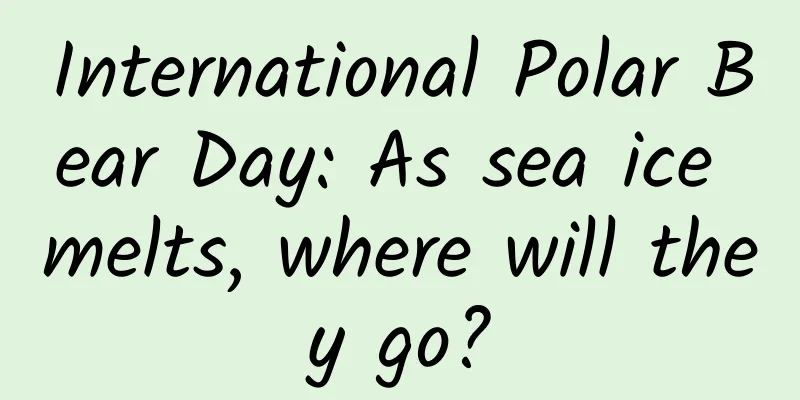International Polar Bear Day: As sea ice melts, where will they go?

|
February 27th of every year It's International Polar Bear Day Established in 2011 by Polar Bears International To remind the whole society Focus on polar bears and their habitat - Arctic These cute "white fat guys" The current situation is not very good Already a “refugee” of climate change As global warming Arctic sea ice is shrinking dramatically This will directly change the fate of the polar bear population Scientists predict About 80 years later No more polar bears in the Arctic Copyright image, no permission to reprint Polar bear: White + black combination Polar bears are the largest bears in existence, weighing an average of 400-800 kilograms and standing up to 9 feet tall. The largest polar bear ever found weighed 1,000 kilograms. About 50,000 years ago, when bears began to settle in the Arctic tundra, which was rich in grass, herbs and strawberries, some of them continued to evolve into seal hunters and survive on the polar ice caps. So from an evolutionary perspective, polar bears are the newest species of bears. Polar bears look very white, but their hair is actually hollow and transparent, and it is the reflection of light that makes them look white. These hairs are heat-insulating and good for camouflage - it is said that infrared cameras can hardly see polar bears on ice and snow. Polar bears have similar vision and hearing to humans, but their sense of smell is far superior to that of humans, 7 times more sensitive than that of dogs. Surprisingly, their skin is black. This can be seen from the black skin around the nose, lips and eyes of polar bears. Black skin helps absorb heat, and "white + black" is an important manifestation of polar bears' adaptation to the cold Arctic. Copyright image, no permission to reprint How does sea ice loss affect polar bears? Currently, most polar bears live near Canada and Greenland, with a small number distributed in Russia and Norway. Polar bears can hunt, mate, and move around on sea ice, and their survival largely depends on sea ice. As a complete ecosystem composed of plankton and microorganisms, sea ice supports a rich food chain, including polar bears' prey - seals. However, as global warming continues, the ice-free area of the Arctic Ocean is getting larger and larger, and the ice-free time is getting longer and longer each year. Polar bears have no choice but to swim long distances between islands to find food, or retreat to further north - the former consumes a lot of physical energy, and the latter cannot find enough food. As a result, many mother bears and cubs cannot accumulate enough body fat, and their survival is in jeopardy. In the southernmost ecoregion, the complete melt of sea ice forces polar bears to come ashore each summer, where, in the absence of energy-dense food, they rely solely on their body's energy reserves to survive and feed. According to statistics, in the past two decades, the surface temperature of the Arctic has increased at twice the global average, which has led to the most serious reduction in the range of Arctic glaciers in a thousand years. In addition to being an important physical platform for polar bears to hunt and raise their cubs, sea ice itself is also a very valuable source of energy - it is covered with many kinds of seaweed, and most of the animals preyed by polar bears will eventually return to this basic food source. The loss of sea ice will not only affect polar bears, but also most of the sea ice microorganisms that form the basis of the food chain. Therefore, in the case of food shortage and human interference, polar bears have begun to become "partial vegetarians" and eat other plant fruits. Even in harsh environments where hunting is more difficult, the Arctic king will be reduced to eating animal carcasses and remains. Even more shocking situations are also happening - polar bears break into villages where humans live, prey on livestock, destroy production and living facilities, and even threaten the personal safety of local residents. In short, polar bears are having a hard time, and the crises and difficulties they face are getting worse day by day. Copyright image, no permission to reprint We are taking action to protect polar bears In August 2015, the World Conservation Union (IUCN) counted the number of polar bears in existence worldwide, which was approximately 26,000 at the time; the updated data in 2018 was 23,000; relevant data show that the number of wild polar bears in 2019 stabilized at around 20,000, showing a downward trend. As early as 1972, the United States enacted a law prohibiting the hunting of polar bears unless polar bears posed a threat to human life. Currently, the Washington Convention CITES (Convention on International Trade in Endangered Species of Wild Fauna and Flora) has listed polar bears in Appendix II, and the IUCN Red List lists them as "vulnerable". The International Polar Bear Organization has also proposed an initiative, calling on humans to support energy conservation and environmental protection, reduce or replace petroleum fuels; support electric and hybrid vehicles, shared cars and public transportation; and encourage people to adopt energy-saving building standards in their living environment. The emergence of these conventions and initiatives has guided humanity in the direction of protecting the Arctic environment. In our daily lives, we can also contribute to ecological environmental protection through some small actions. Saving an Ice Block for Polar Bears Start with you and me Comprehensive sources: China News Network, Beijing Association for Science and Technology, Shanghai Natural History Museum The cover image and the images in this article are from the copyright gallery and are not authorized for reproduction |
<<: Learning Card丨What is the significance of strengthening basic research?
Recommend
Short video information flow picture material optimization case
In recent years, disputes in the short video indu...
Is the nuclear radiation from CT scan, a magical tool for cancer detection, very harmful? Nuclide: I am innocent...
The "nuclear" thing has long been widel...
Online and offline framework for second-hand car live broadcast room!
In the traditional search for used car sources, u...
"Trimming horse hooves, washing carpets, squeezing blackheads..." Why can't you stop watching these videos?
Produced by: Science Popularization China Author:...
Chery Fengyun T9 and BYD Song L DM-i, which one is more worth buying?
On October 13, Chery announced the launch of its ...
Unveiling the secrets of WeChat reading volume: Who controls the profit chain?
The number of WeChat readings is becoming the mos...
Where does pufferfish's toxicity come from and how can we eat them safely?
Hilsa shad, razor fish and puffer fish are collec...
How to find accurate drainage methods?
There is a cruel fact: the online traffic dividen...
Why Public Wi-Fi Is Unsafe
We often hear warnings from security experts that...
10 Key Steps to Turn Your Mobile App Idea into Reality
Many individuals and companies come up with new m...
How to Eat Smart in Winter | Chinese Famous Food "Hot Pot"
Every winter, people always like to gather 3-5 fr...
ASO Optimization: How to write a good APP description introduction?
APP description has a great impact on the current...
When smart cars and low-desire life go against each other, who will pay for our future travel?
Why can a Weilai car manufactured by JAC sell for...
Understand "How to apply for Xiaomi's first release for APP" in 3 minutes
This article is also known as " Xiaomi App S...
In-depth analysis of information flow delivery, the key method to rapidly increase ROI
What exactly is advertising, trying to convince y...









